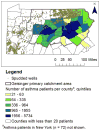Association Between Unconventional Natural Gas Development in the Marcellus Shale and Asthma Exacerbations
- PMID: 27428612
- PMCID: PMC5424822
- DOI: 10.1001/jamainternmed.2016.2436
Association Between Unconventional Natural Gas Development in the Marcellus Shale and Asthma Exacerbations
Abstract
Importance: Asthma is common and can be exacerbated by air pollution and stress. Unconventional natural gas development (UNGD) has community and environmental impacts. In Pennsylvania, UNGD began in 2005, and by 2012, 6253 wells had been drilled. There are no prior studies of UNGD and objective respiratory outcomes.
Objective: To evaluate associations between UNGD and asthma exacerbations.
Design: A nested case-control study comparing patients with asthma with and without exacerbations from 2005 through 2012 treated at the Geisinger Clinic, which provides primary care services to over 400 000 patients in Pennsylvania. Patients with asthma aged 5 to 90 years (n = 35 508) were identified in electronic health records; those with exacerbations were frequency matched on age, sex, and year of event to those without.
Exposures: On the day before each patient's index date (cases, date of event or medication order; controls, contact date), we estimated activity metrics for 4 UNGD phases (pad preparation, drilling, stimulation [hydraulic fracturing, or "fracking"], and production) using distance from the patient's home to the well, well characteristics, and the dates and durations of phases.
Main outcomes and measures: We identified and defined asthma exacerbations as mild (new oral corticosteroid medication order), moderate (emergency department encounter), or severe (hospitalization).
Results: We identified 20 749 mild, 1870 moderate, and 4782 severe asthma exacerbations, and frequency matched these to 18 693, 9350, and 14 104 control index dates, respectively. In 3-level adjusted models, there was an association between the highest group of the activity metric for each UNGD phase compared with the lowest group for 11 of 12 UNGD-outcome pairs: odds ratios (ORs) ranged from 1.5 (95% CI, 1.2-1.7) for the association of the pad metric with severe exacerbations to 4.4 (95% CI, 3.8-5.2) for the association of the production metric with mild exacerbations. Six of the 12 UNGD-outcome associations had increasing ORs across quartiles. Our findings were robust to increasing levels of covariate control and in sensitivity analyses that included evaluation of some possible sources of unmeasured confounding.
Conclusions and relevance: Residential UNGD activity metrics were statistically associated with increased risk of mild, moderate, and severe asthma exacerbations. Whether these associations are causal awaits further investigation, including more detailed exposure assessment.
Conflict of interest statement
We declare that we have no conflicts of interest.
Figures



Similar articles
-
Unconventional natural gas development and pediatric asthma hospitalizations in Pennsylvania.Environ Res. 2018 Oct;166:402-408. doi: 10.1016/j.envres.2018.06.022. Epub 2018 Jun 21. Environ Res. 2018. PMID: 29936288 Free PMC article.
-
Unconventional Natural Gas Development and Hospitalization for Heart Failure in Pennsylvania.J Am Coll Cardiol. 2020 Dec 15;76(24):2862-2874. doi: 10.1016/j.jacc.2020.10.023. J Am Coll Cardiol. 2020. PMID: 33303076 Free PMC article.
-
Cumulative Exposure to Unconventional Natural Gas Development and the Risk of Childhood Cancer: A Registry-Based Case-Control Study.Int J Environ Res Public Health. 2025 Jan 7;22(1):68. doi: 10.3390/ijerph22010068. Int J Environ Res Public Health. 2025. PMID: 39857520 Free PMC article.
-
Unconventional oil and gas development and health outcomes: A scoping review of the epidemiological research.Environ Res. 2020 Mar;182:109124. doi: 10.1016/j.envres.2020.109124. Epub 2020 Jan 8. Environ Res. 2020. PMID: 32069745
-
Understanding exposure from natural gas drilling puts current air standards to the test.Rev Environ Health. 2014;29(4):277-92. doi: 10.1515/reveh-2014-0002. Rev Environ Health. 2014. PMID: 24690938 Review.
Cited by
-
Unconventional natural gas development and pediatric asthma hospitalizations in Pennsylvania.Environ Res. 2018 Oct;166:402-408. doi: 10.1016/j.envres.2018.06.022. Epub 2018 Jun 21. Environ Res. 2018. PMID: 29936288 Free PMC article.
-
Developmental Exposure to a Mixture of 23 Chemicals Associated With Unconventional Oil and Gas Operations Alters the Immune System of Mice.Toxicol Sci. 2018 Jun 1;163(2):639-654. doi: 10.1093/toxsci/kfy066. Toxicol Sci. 2018. PMID: 29718478 Free PMC article.
-
Unconventional Natural Gas Development and Hospitalization for Heart Failure in Pennsylvania.J Am Coll Cardiol. 2020 Dec 15;76(24):2862-2874. doi: 10.1016/j.jacc.2020.10.023. J Am Coll Cardiol. 2020. PMID: 33303076 Free PMC article.
-
Cumulative Human Health Risk Assessment of Regional Ozone and Volatile Organic Compounds from Unconventional Oil and Gas Sites in Colorado's Front Range.Environ Health Perspect. 2025 May;133(5):57025. doi: 10.1289/EHP16272. Epub 2025 May 28. Environ Health Perspect. 2025. PMID: 40305737 Free PMC article.
-
Assessing Agreement in Exposure Classification between Proximity-Based Metrics and Air Monitoring Data in Epidemiology Studies of Unconventional Resource Development.Int J Environ Res Public Health. 2019 Aug 23;16(17):3055. doi: 10.3390/ijerph16173055. Int J Environ Res Public Health. 2019. PMID: 31443587 Free PMC article.
References
-
- Moorman JE, Akinbami LJ, Bailey CM, Johnson CA, et al. National surveillance of asthma: United States, 2001–2010. National Center for Health Statistics, Vital Health Stat. 2012;3:35. - PubMed
-
- National Heart, Lung, and Blood Institute. Expert panel report 3: Guidelines for the diagnosis and management of asthma: Full report. US Department of Health and Human Services, National Institutes of Health, National Heart, Lung, and Blood Institute; 2007. National Asthma Education Program. Expert Panel on the Management of Asthma.
-
- Gent JF, Triche EW, Holford TR, et al. Association of low-level ozone and fine particles with respiratory symptoms in children with asthma. JAMA. 2003;290(14):1859–1867. - PubMed
MeSH terms
Substances
Grants and funding
LinkOut - more resources
Full Text Sources
Other Literature Sources
Medical

